Report: APIC Sydney Branch Network Infrastructure and Cloud Solutions
VerifiedAdded on 2023/01/23
|17
|3737
|93
Report
AI Summary
This report provides a comprehensive assessment of the IT infrastructure requirements for the new Sydney branch of Asia Pacific International College (APIC). It begins by outlining the global network scope, including the underlying equipment and their use cases, followed by logical and physical n...

Running head: APIC IT INFRASTRUCTURE
APIC IT Infrastructure
Name of the Student
Name of the University
Author Note
APIC IT Infrastructure
Name of the Student
Name of the University
Author Note
Paraphrase This Document
Need a fresh take? Get an instant paraphrase of this document with our AI Paraphraser
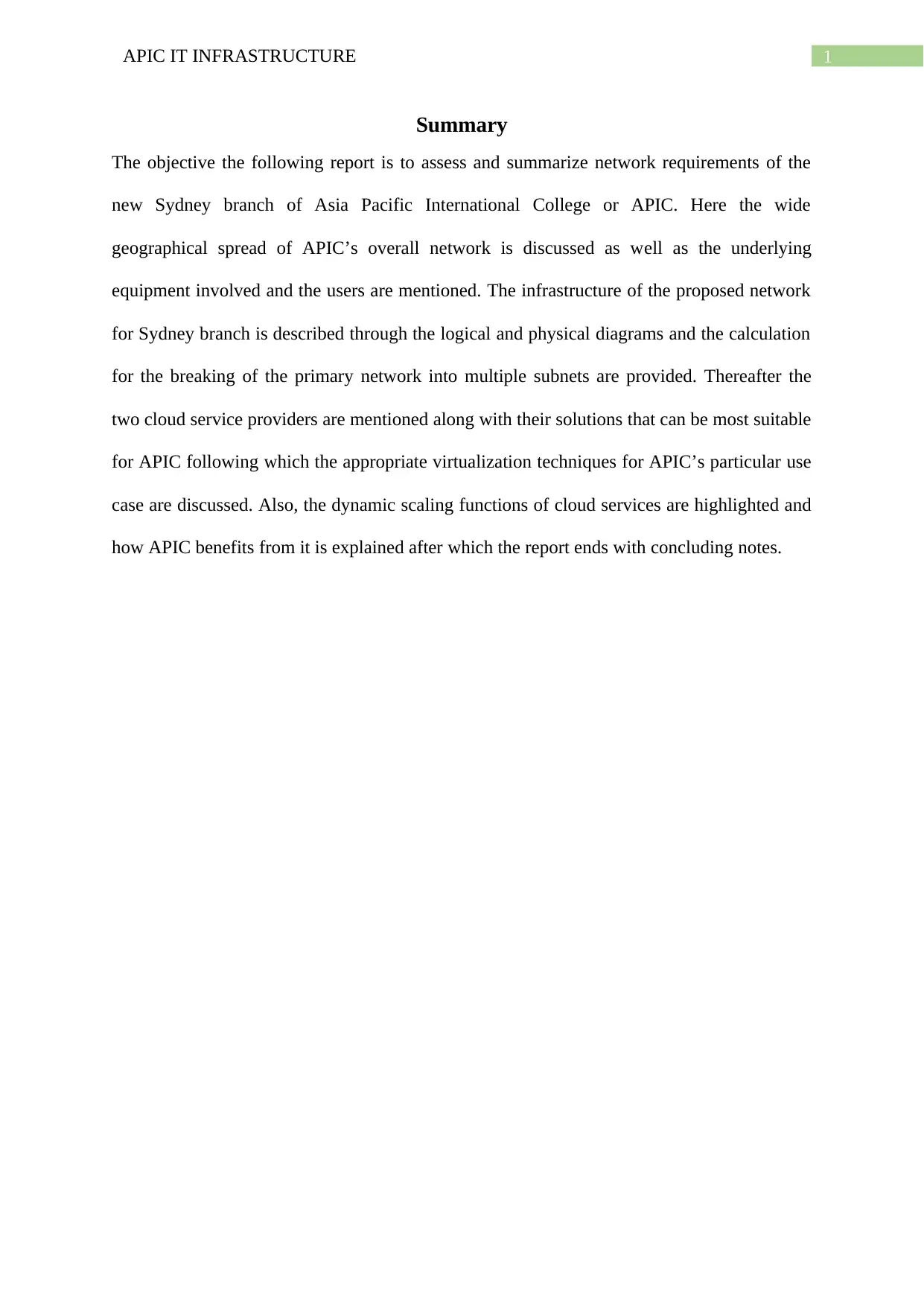
1APIC IT INFRASTRUCTURE
Summary
The objective the following report is to assess and summarize network requirements of the
new Sydney branch of Asia Pacific International College or APIC. Here the wide
geographical spread of APIC’s overall network is discussed as well as the underlying
equipment involved and the users are mentioned. The infrastructure of the proposed network
for Sydney branch is described through the logical and physical diagrams and the calculation
for the breaking of the primary network into multiple subnets are provided. Thereafter the
two cloud service providers are mentioned along with their solutions that can be most suitable
for APIC following which the appropriate virtualization techniques for APIC’s particular use
case are discussed. Also, the dynamic scaling functions of cloud services are highlighted and
how APIC benefits from it is explained after which the report ends with concluding notes.
Summary
The objective the following report is to assess and summarize network requirements of the
new Sydney branch of Asia Pacific International College or APIC. Here the wide
geographical spread of APIC’s overall network is discussed as well as the underlying
equipment involved and the users are mentioned. The infrastructure of the proposed network
for Sydney branch is described through the logical and physical diagrams and the calculation
for the breaking of the primary network into multiple subnets are provided. Thereafter the
two cloud service providers are mentioned along with their solutions that can be most suitable
for APIC following which the appropriate virtualization techniques for APIC’s particular use
case are discussed. Also, the dynamic scaling functions of cloud services are highlighted and
how APIC benefits from it is explained after which the report ends with concluding notes.
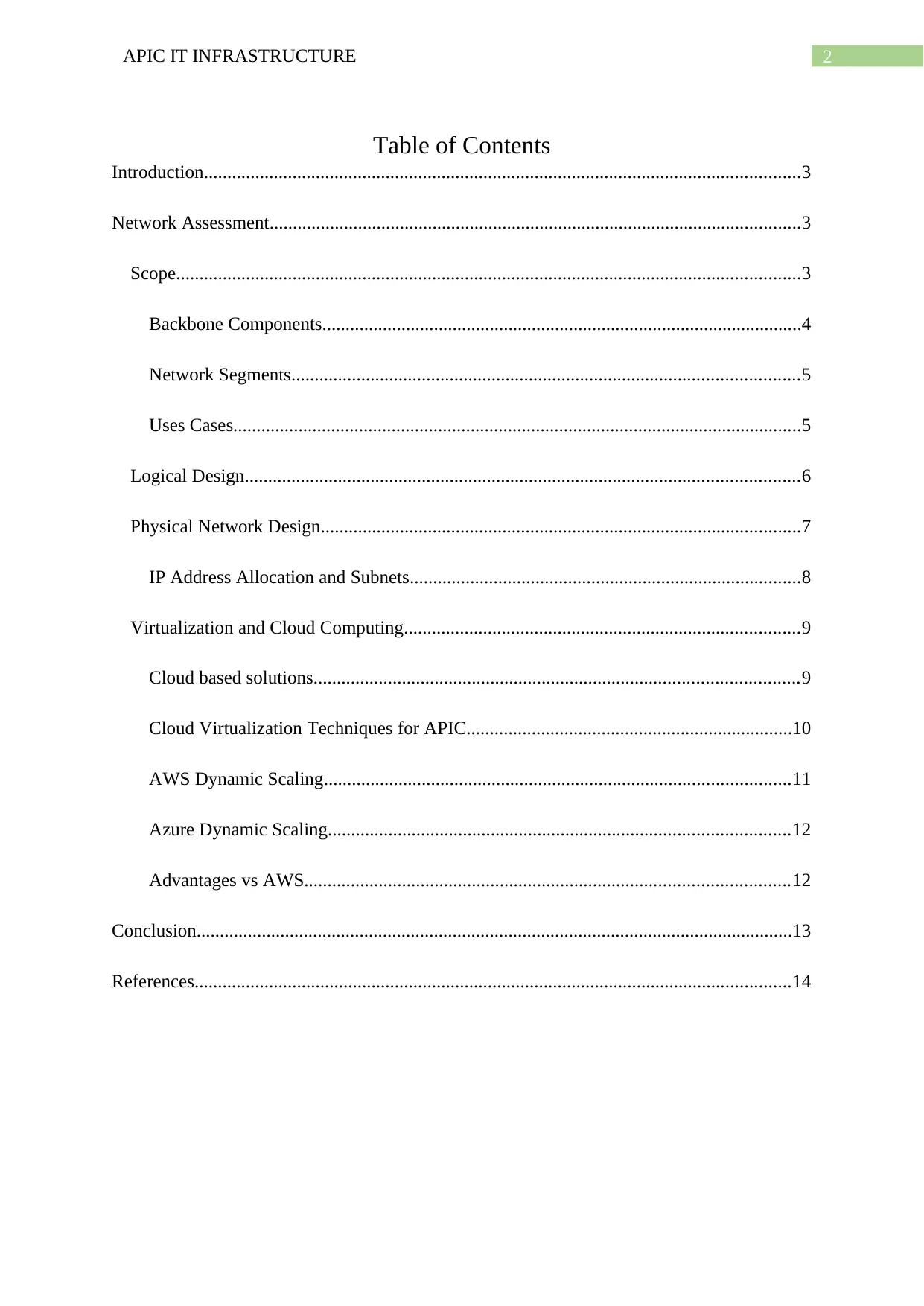
2APIC IT INFRASTRUCTURE
Table of Contents
Introduction................................................................................................................................3
Network Assessment..................................................................................................................3
Scope......................................................................................................................................3
Backbone Components.......................................................................................................4
Network Segments.............................................................................................................5
Uses Cases..........................................................................................................................5
Logical Design.......................................................................................................................6
Physical Network Design.......................................................................................................7
IP Address Allocation and Subnets....................................................................................8
Virtualization and Cloud Computing.....................................................................................9
Cloud based solutions........................................................................................................9
Cloud Virtualization Techniques for APIC......................................................................10
AWS Dynamic Scaling....................................................................................................11
Azure Dynamic Scaling...................................................................................................12
Advantages vs AWS........................................................................................................12
Conclusion................................................................................................................................13
References................................................................................................................................14
Table of Contents
Introduction................................................................................................................................3
Network Assessment..................................................................................................................3
Scope......................................................................................................................................3
Backbone Components.......................................................................................................4
Network Segments.............................................................................................................5
Uses Cases..........................................................................................................................5
Logical Design.......................................................................................................................6
Physical Network Design.......................................................................................................7
IP Address Allocation and Subnets....................................................................................8
Virtualization and Cloud Computing.....................................................................................9
Cloud based solutions........................................................................................................9
Cloud Virtualization Techniques for APIC......................................................................10
AWS Dynamic Scaling....................................................................................................11
Azure Dynamic Scaling...................................................................................................12
Advantages vs AWS........................................................................................................12
Conclusion................................................................................................................................13
References................................................................................................................................14
⊘ This is a preview!⊘
Do you want full access?
Subscribe today to unlock all pages.

Trusted by 1+ million students worldwide
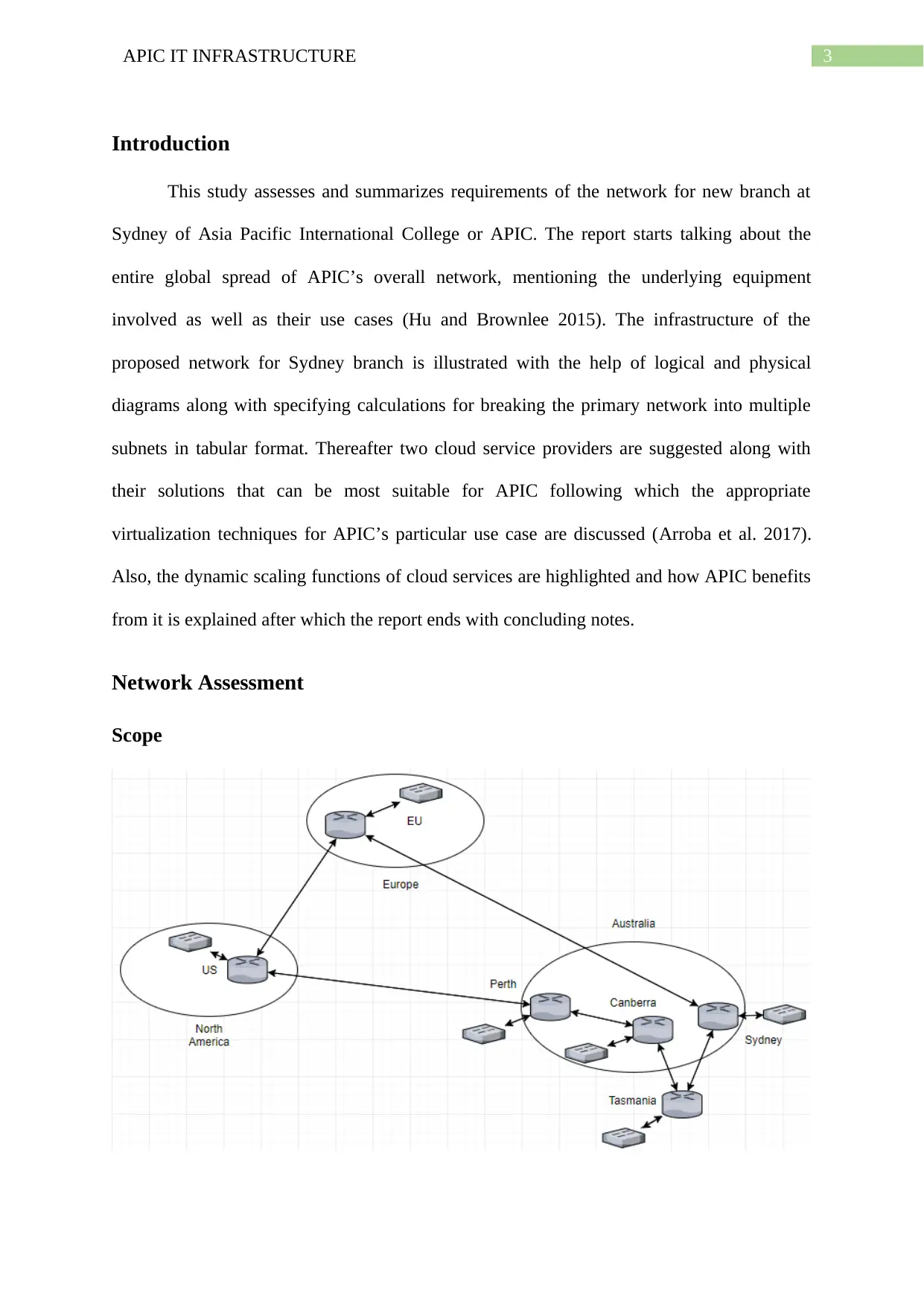
3APIC IT INFRASTRUCTURE
Introduction
This study assesses and summarizes requirements of the network for new branch at
Sydney of Asia Pacific International College or APIC. The report starts talking about the
entire global spread of APIC’s overall network, mentioning the underlying equipment
involved as well as their use cases (Hu and Brownlee 2015). The infrastructure of the
proposed network for Sydney branch is illustrated with the help of logical and physical
diagrams along with specifying calculations for breaking the primary network into multiple
subnets in tabular format. Thereafter two cloud service providers are suggested along with
their solutions that can be most suitable for APIC following which the appropriate
virtualization techniques for APIC’s particular use case are discussed (Arroba et al. 2017).
Also, the dynamic scaling functions of cloud services are highlighted and how APIC benefits
from it is explained after which the report ends with concluding notes.
Network Assessment
Scope
Introduction
This study assesses and summarizes requirements of the network for new branch at
Sydney of Asia Pacific International College or APIC. The report starts talking about the
entire global spread of APIC’s overall network, mentioning the underlying equipment
involved as well as their use cases (Hu and Brownlee 2015). The infrastructure of the
proposed network for Sydney branch is illustrated with the help of logical and physical
diagrams along with specifying calculations for breaking the primary network into multiple
subnets in tabular format. Thereafter two cloud service providers are suggested along with
their solutions that can be most suitable for APIC following which the appropriate
virtualization techniques for APIC’s particular use case are discussed (Arroba et al. 2017).
Also, the dynamic scaling functions of cloud services are highlighted and how APIC benefits
from it is explained after which the report ends with concluding notes.
Network Assessment
Scope
Paraphrase This Document
Need a fresh take? Get an instant paraphrase of this document with our AI Paraphraser
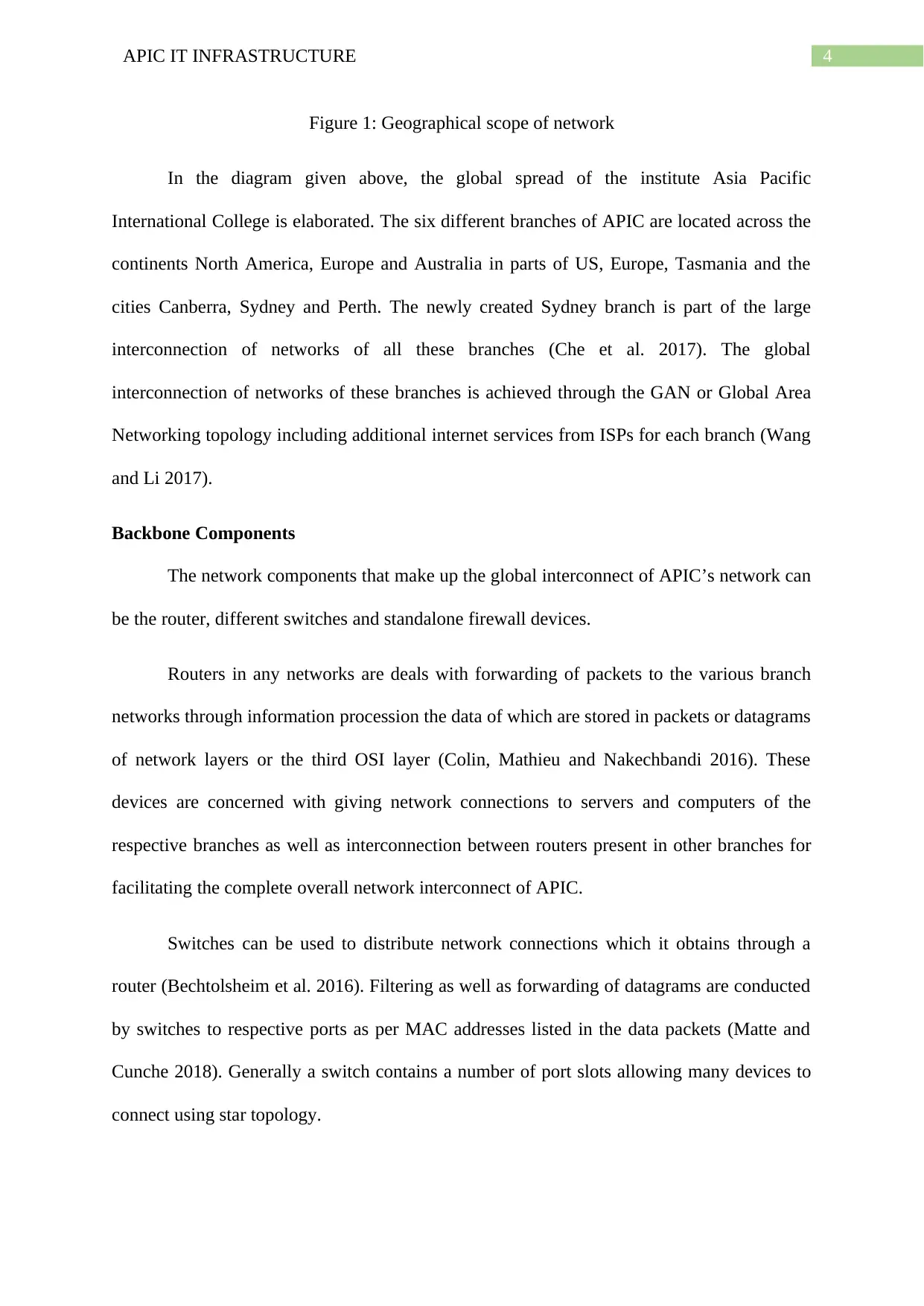
4APIC IT INFRASTRUCTURE
Figure 1: Geographical scope of network
In the diagram given above, the global spread of the institute Asia Pacific
International College is elaborated. The six different branches of APIC are located across the
continents North America, Europe and Australia in parts of US, Europe, Tasmania and the
cities Canberra, Sydney and Perth. The newly created Sydney branch is part of the large
interconnection of networks of all these branches (Che et al. 2017). The global
interconnection of networks of these branches is achieved through the GAN or Global Area
Networking topology including additional internet services from ISPs for each branch (Wang
and Li 2017).
Backbone Components
The network components that make up the global interconnect of APIC’s network can
be the router, different switches and standalone firewall devices.
Routers in any networks are deals with forwarding of packets to the various branch
networks through information procession the data of which are stored in packets or datagrams
of network layers or the third OSI layer (Colin, Mathieu and Nakechbandi 2016). These
devices are concerned with giving network connections to servers and computers of the
respective branches as well as interconnection between routers present in other branches for
facilitating the complete overall network interconnect of APIC.
Switches can be used to distribute network connections which it obtains through a
router (Bechtolsheim et al. 2016). Filtering as well as forwarding of datagrams are conducted
by switches to respective ports as per MAC addresses listed in the data packets (Matte and
Cunche 2018). Generally a switch contains a number of port slots allowing many devices to
connect using star topology.
Figure 1: Geographical scope of network
In the diagram given above, the global spread of the institute Asia Pacific
International College is elaborated. The six different branches of APIC are located across the
continents North America, Europe and Australia in parts of US, Europe, Tasmania and the
cities Canberra, Sydney and Perth. The newly created Sydney branch is part of the large
interconnection of networks of all these branches (Che et al. 2017). The global
interconnection of networks of these branches is achieved through the GAN or Global Area
Networking topology including additional internet services from ISPs for each branch (Wang
and Li 2017).
Backbone Components
The network components that make up the global interconnect of APIC’s network can
be the router, different switches and standalone firewall devices.
Routers in any networks are deals with forwarding of packets to the various branch
networks through information procession the data of which are stored in packets or datagrams
of network layers or the third OSI layer (Colin, Mathieu and Nakechbandi 2016). These
devices are concerned with giving network connections to servers and computers of the
respective branches as well as interconnection between routers present in other branches for
facilitating the complete overall network interconnect of APIC.
Switches can be used to distribute network connections which it obtains through a
router (Bechtolsheim et al. 2016). Filtering as well as forwarding of datagrams are conducted
by switches to respective ports as per MAC addresses listed in the data packets (Matte and
Cunche 2018). Generally a switch contains a number of port slots allowing many devices to
connect using star topology.
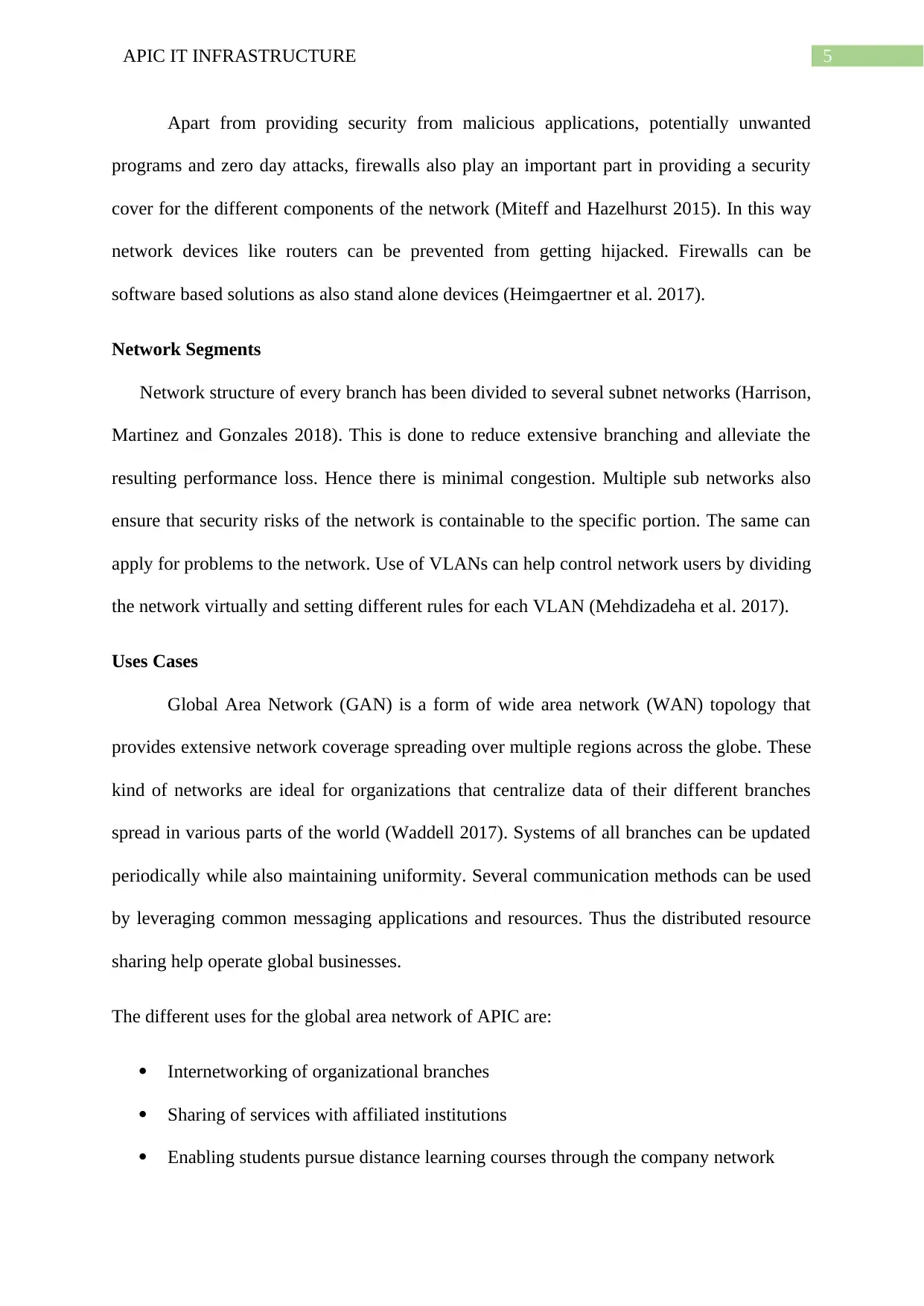
5APIC IT INFRASTRUCTURE
Apart from providing security from malicious applications, potentially unwanted
programs and zero day attacks, firewalls also play an important part in providing a security
cover for the different components of the network (Miteff and Hazelhurst 2015). In this way
network devices like routers can be prevented from getting hijacked. Firewalls can be
software based solutions as also stand alone devices (Heimgaertner et al. 2017).
Network Segments
Network structure of every branch has been divided to several subnet networks (Harrison,
Martinez and Gonzales 2018). This is done to reduce extensive branching and alleviate the
resulting performance loss. Hence there is minimal congestion. Multiple sub networks also
ensure that security risks of the network is containable to the specific portion. The same can
apply for problems to the network. Use of VLANs can help control network users by dividing
the network virtually and setting different rules for each VLAN (Mehdizadeha et al. 2017).
Uses Cases
Global Area Network (GAN) is a form of wide area network (WAN) topology that
provides extensive network coverage spreading over multiple regions across the globe. These
kind of networks are ideal for organizations that centralize data of their different branches
spread in various parts of the world (Waddell 2017). Systems of all branches can be updated
periodically while also maintaining uniformity. Several communication methods can be used
by leveraging common messaging applications and resources. Thus the distributed resource
sharing help operate global businesses.
The different uses for the global area network of APIC are:
Internetworking of organizational branches
Sharing of services with affiliated institutions
Enabling students pursue distance learning courses through the company network
Apart from providing security from malicious applications, potentially unwanted
programs and zero day attacks, firewalls also play an important part in providing a security
cover for the different components of the network (Miteff and Hazelhurst 2015). In this way
network devices like routers can be prevented from getting hijacked. Firewalls can be
software based solutions as also stand alone devices (Heimgaertner et al. 2017).
Network Segments
Network structure of every branch has been divided to several subnet networks (Harrison,
Martinez and Gonzales 2018). This is done to reduce extensive branching and alleviate the
resulting performance loss. Hence there is minimal congestion. Multiple sub networks also
ensure that security risks of the network is containable to the specific portion. The same can
apply for problems to the network. Use of VLANs can help control network users by dividing
the network virtually and setting different rules for each VLAN (Mehdizadeha et al. 2017).
Uses Cases
Global Area Network (GAN) is a form of wide area network (WAN) topology that
provides extensive network coverage spreading over multiple regions across the globe. These
kind of networks are ideal for organizations that centralize data of their different branches
spread in various parts of the world (Waddell 2017). Systems of all branches can be updated
periodically while also maintaining uniformity. Several communication methods can be used
by leveraging common messaging applications and resources. Thus the distributed resource
sharing help operate global businesses.
The different uses for the global area network of APIC are:
Internetworking of organizational branches
Sharing of services with affiliated institutions
Enabling students pursue distance learning courses through the company network
⊘ This is a preview!⊘
Do you want full access?
Subscribe today to unlock all pages.

Trusted by 1+ million students worldwide
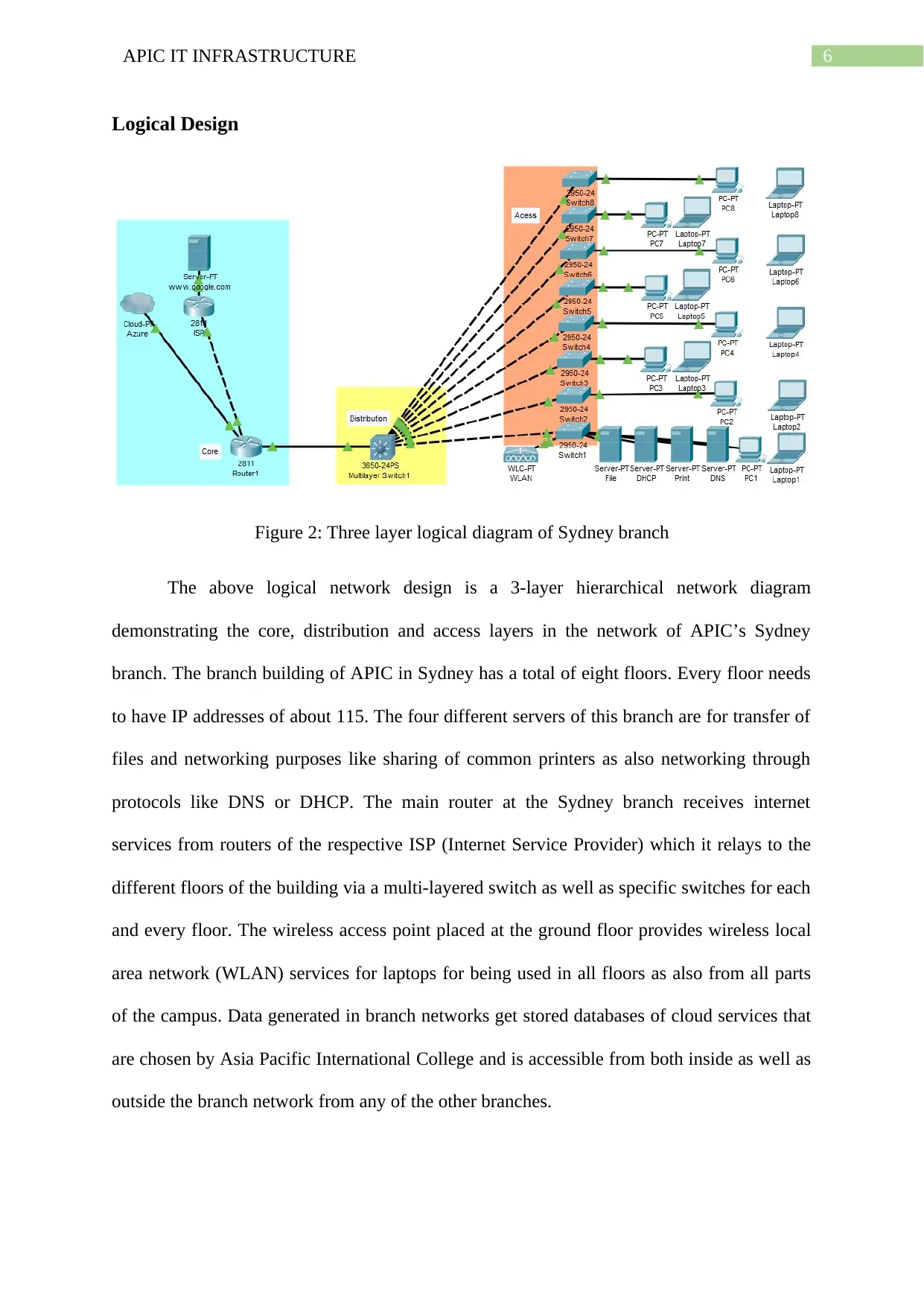
6APIC IT INFRASTRUCTURE
Logical Design
Figure 2: Three layer logical diagram of Sydney branch
The above logical network design is a 3-layer hierarchical network diagram
demonstrating the core, distribution and access layers in the network of APIC’s Sydney
branch. The branch building of APIC in Sydney has a total of eight floors. Every floor needs
to have IP addresses of about 115. The four different servers of this branch are for transfer of
files and networking purposes like sharing of common printers as also networking through
protocols like DNS or DHCP. The main router at the Sydney branch receives internet
services from routers of the respective ISP (Internet Service Provider) which it relays to the
different floors of the building via a multi-layered switch as well as specific switches for each
and every floor. The wireless access point placed at the ground floor provides wireless local
area network (WLAN) services for laptops for being used in all floors as also from all parts
of the campus. Data generated in branch networks get stored databases of cloud services that
are chosen by Asia Pacific International College and is accessible from both inside as well as
outside the branch network from any of the other branches.
Logical Design
Figure 2: Three layer logical diagram of Sydney branch
The above logical network design is a 3-layer hierarchical network diagram
demonstrating the core, distribution and access layers in the network of APIC’s Sydney
branch. The branch building of APIC in Sydney has a total of eight floors. Every floor needs
to have IP addresses of about 115. The four different servers of this branch are for transfer of
files and networking purposes like sharing of common printers as also networking through
protocols like DNS or DHCP. The main router at the Sydney branch receives internet
services from routers of the respective ISP (Internet Service Provider) which it relays to the
different floors of the building via a multi-layered switch as well as specific switches for each
and every floor. The wireless access point placed at the ground floor provides wireless local
area network (WLAN) services for laptops for being used in all floors as also from all parts
of the campus. Data generated in branch networks get stored databases of cloud services that
are chosen by Asia Pacific International College and is accessible from both inside as well as
outside the branch network from any of the other branches.
Paraphrase This Document
Need a fresh take? Get an instant paraphrase of this document with our AI Paraphraser
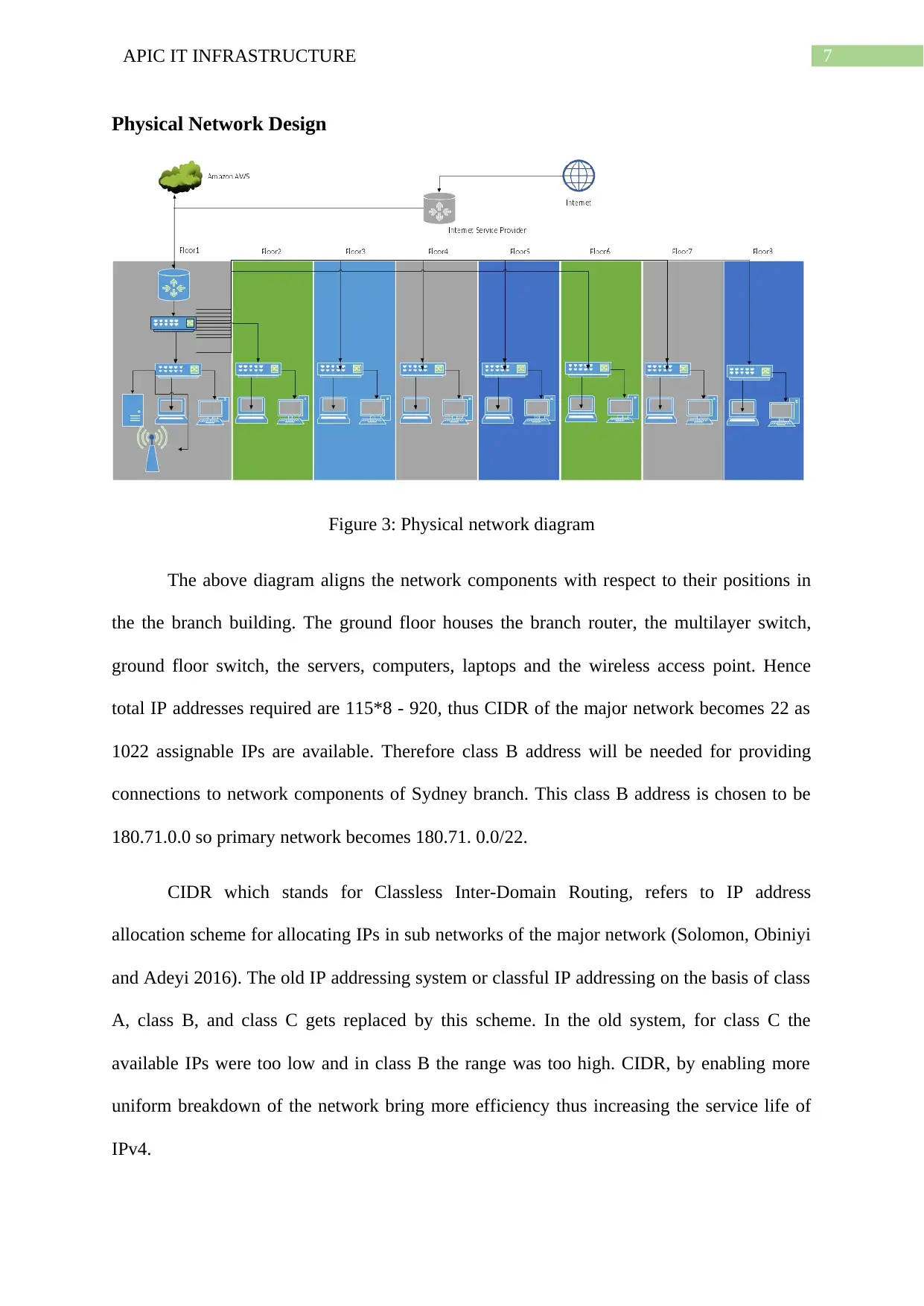
7APIC IT INFRASTRUCTURE
Physical Network Design
Figure 3: Physical network diagram
The above diagram aligns the network components with respect to their positions in
the the branch building. The ground floor houses the branch router, the multilayer switch,
ground floor switch, the servers, computers, laptops and the wireless access point. Hence
total IP addresses required are 115*8 - 920, thus CIDR of the major network becomes 22 as
1022 assignable IPs are available. Therefore class B address will be needed for providing
connections to network components of Sydney branch. This class B address is chosen to be
180.71.0.0 so primary network becomes 180.71. 0.0/22.
CIDR which stands for Classless Inter-Domain Routing, refers to IP address
allocation scheme for allocating IPs in sub networks of the major network (Solomon, Obiniyi
and Adeyi 2016). The old IP addressing system or classful IP addressing on the basis of class
A, class B, and class C gets replaced by this scheme. In the old system, for class C the
available IPs were too low and in class B the range was too high. CIDR, by enabling more
uniform breakdown of the network bring more efficiency thus increasing the service life of
IPv4.
Physical Network Design
Figure 3: Physical network diagram
The above diagram aligns the network components with respect to their positions in
the the branch building. The ground floor houses the branch router, the multilayer switch,
ground floor switch, the servers, computers, laptops and the wireless access point. Hence
total IP addresses required are 115*8 - 920, thus CIDR of the major network becomes 22 as
1022 assignable IPs are available. Therefore class B address will be needed for providing
connections to network components of Sydney branch. This class B address is chosen to be
180.71.0.0 so primary network becomes 180.71. 0.0/22.
CIDR which stands for Classless Inter-Domain Routing, refers to IP address
allocation scheme for allocating IPs in sub networks of the major network (Solomon, Obiniyi
and Adeyi 2016). The old IP addressing system or classful IP addressing on the basis of class
A, class B, and class C gets replaced by this scheme. In the old system, for class C the
available IPs were too low and in class B the range was too high. CIDR, by enabling more
uniform breakdown of the network bring more efficiency thus increasing the service life of
IPv4.
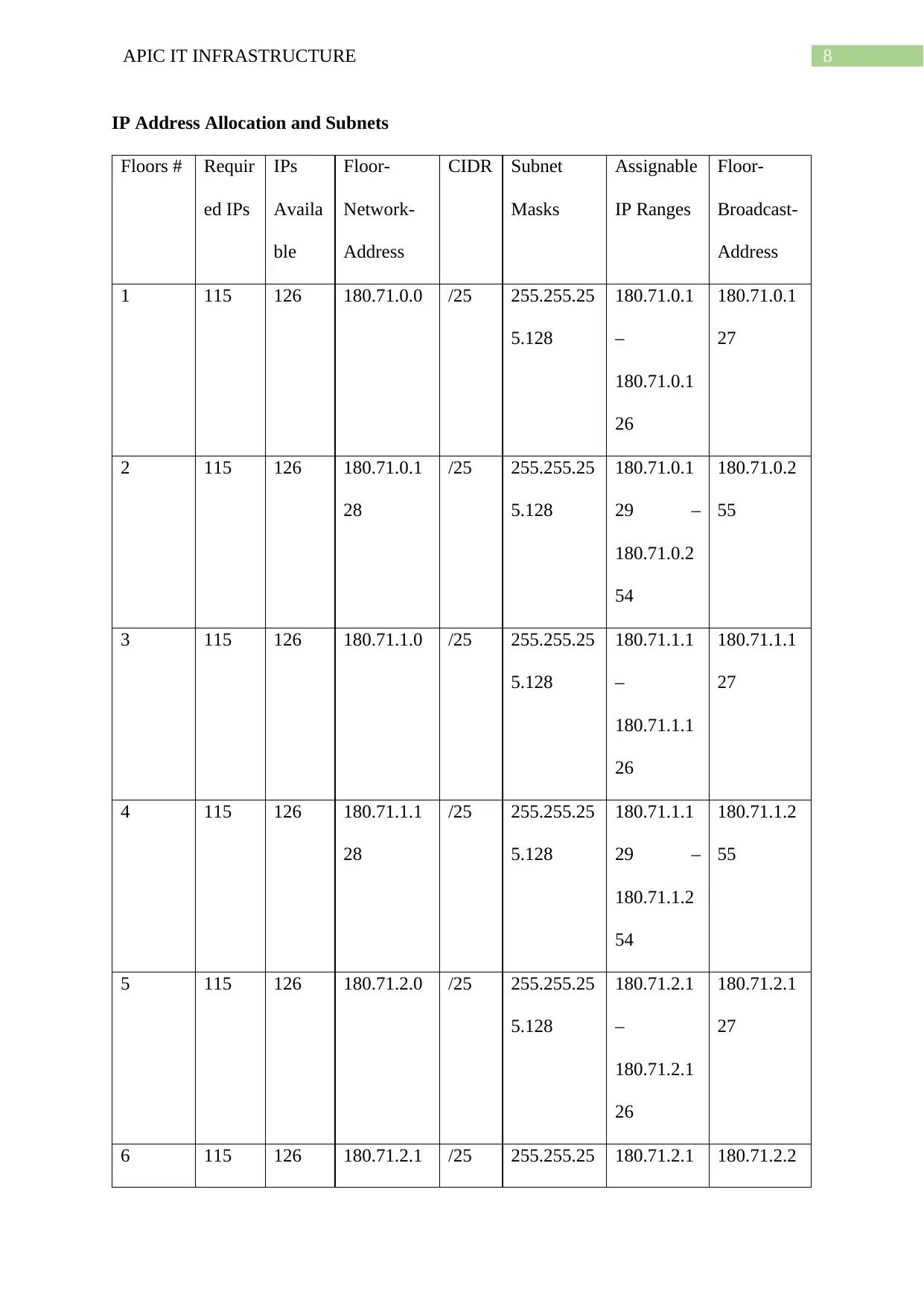
8APIC IT INFRASTRUCTURE
IP Address Allocation and Subnets
Floors # Requir
ed IPs
IPs
Availa
ble
Floor-
Network-
Address
CIDR Subnet
Masks
Assignable
IP Ranges
Floor-
Broadcast-
Address
1 115 126 180.71.0.0 /25 255.255.25
5.128
180.71.0.1
–
180.71.0.1
26
180.71.0.1
27
2 115 126 180.71.0.1
28
/25 255.255.25
5.128
180.71.0.1
29 –
180.71.0.2
54
180.71.0.2
55
3 115 126 180.71.1.0 /25 255.255.25
5.128
180.71.1.1
–
180.71.1.1
26
180.71.1.1
27
4 115 126 180.71.1.1
28
/25 255.255.25
5.128
180.71.1.1
29 –
180.71.1.2
54
180.71.1.2
55
5 115 126 180.71.2.0 /25 255.255.25
5.128
180.71.2.1
–
180.71.2.1
26
180.71.2.1
27
6 115 126 180.71.2.1 /25 255.255.25 180.71.2.1 180.71.2.2
IP Address Allocation and Subnets
Floors # Requir
ed IPs
IPs
Availa
ble
Floor-
Network-
Address
CIDR Subnet
Masks
Assignable
IP Ranges
Floor-
Broadcast-
Address
1 115 126 180.71.0.0 /25 255.255.25
5.128
180.71.0.1
–
180.71.0.1
26
180.71.0.1
27
2 115 126 180.71.0.1
28
/25 255.255.25
5.128
180.71.0.1
29 –
180.71.0.2
54
180.71.0.2
55
3 115 126 180.71.1.0 /25 255.255.25
5.128
180.71.1.1
–
180.71.1.1
26
180.71.1.1
27
4 115 126 180.71.1.1
28
/25 255.255.25
5.128
180.71.1.1
29 –
180.71.1.2
54
180.71.1.2
55
5 115 126 180.71.2.0 /25 255.255.25
5.128
180.71.2.1
–
180.71.2.1
26
180.71.2.1
27
6 115 126 180.71.2.1 /25 255.255.25 180.71.2.1 180.71.2.2
⊘ This is a preview!⊘
Do you want full access?
Subscribe today to unlock all pages.

Trusted by 1+ million students worldwide
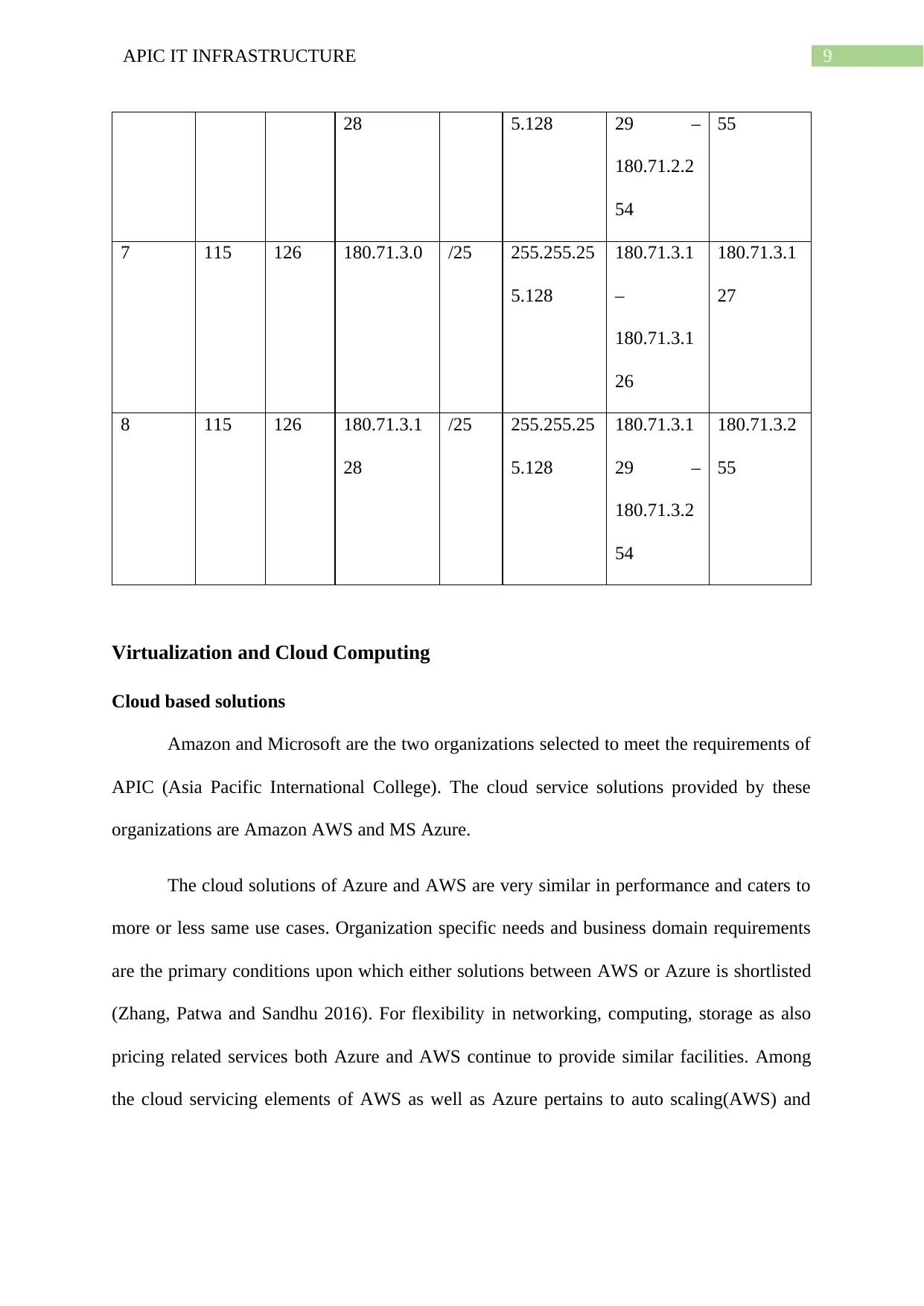
9APIC IT INFRASTRUCTURE
28 5.128 29 –
180.71.2.2
54
55
7 115 126 180.71.3.0 /25 255.255.25
5.128
180.71.3.1
–
180.71.3.1
26
180.71.3.1
27
8 115 126 180.71.3.1
28
/25 255.255.25
5.128
180.71.3.1
29 –
180.71.3.2
54
180.71.3.2
55
Virtualization and Cloud Computing
Cloud based solutions
Amazon and Microsoft are the two organizations selected to meet the requirements of
APIC (Asia Pacific International College). The cloud service solutions provided by these
organizations are Amazon AWS and MS Azure.
The cloud solutions of Azure and AWS are very similar in performance and caters to
more or less same use cases. Organization specific needs and business domain requirements
are the primary conditions upon which either solutions between AWS or Azure is shortlisted
(Zhang, Patwa and Sandhu 2016). For flexibility in networking, computing, storage as also
pricing related services both Azure and AWS continue to provide similar facilities. Among
the cloud servicing elements of AWS as well as Azure pertains to auto scaling(AWS) and
28 5.128 29 –
180.71.2.2
54
55
7 115 126 180.71.3.0 /25 255.255.25
5.128
180.71.3.1
–
180.71.3.1
26
180.71.3.1
27
8 115 126 180.71.3.1
28
/25 255.255.25
5.128
180.71.3.1
29 –
180.71.3.2
54
180.71.3.2
55
Virtualization and Cloud Computing
Cloud based solutions
Amazon and Microsoft are the two organizations selected to meet the requirements of
APIC (Asia Pacific International College). The cloud service solutions provided by these
organizations are Amazon AWS and MS Azure.
The cloud solutions of Azure and AWS are very similar in performance and caters to
more or less same use cases. Organization specific needs and business domain requirements
are the primary conditions upon which either solutions between AWS or Azure is shortlisted
(Zhang, Patwa and Sandhu 2016). For flexibility in networking, computing, storage as also
pricing related services both Azure and AWS continue to provide similar facilities. Among
the cloud servicing elements of AWS as well as Azure pertains to auto scaling(AWS) and
Paraphrase This Document
Need a fresh take? Get an instant paraphrase of this document with our AI Paraphraser
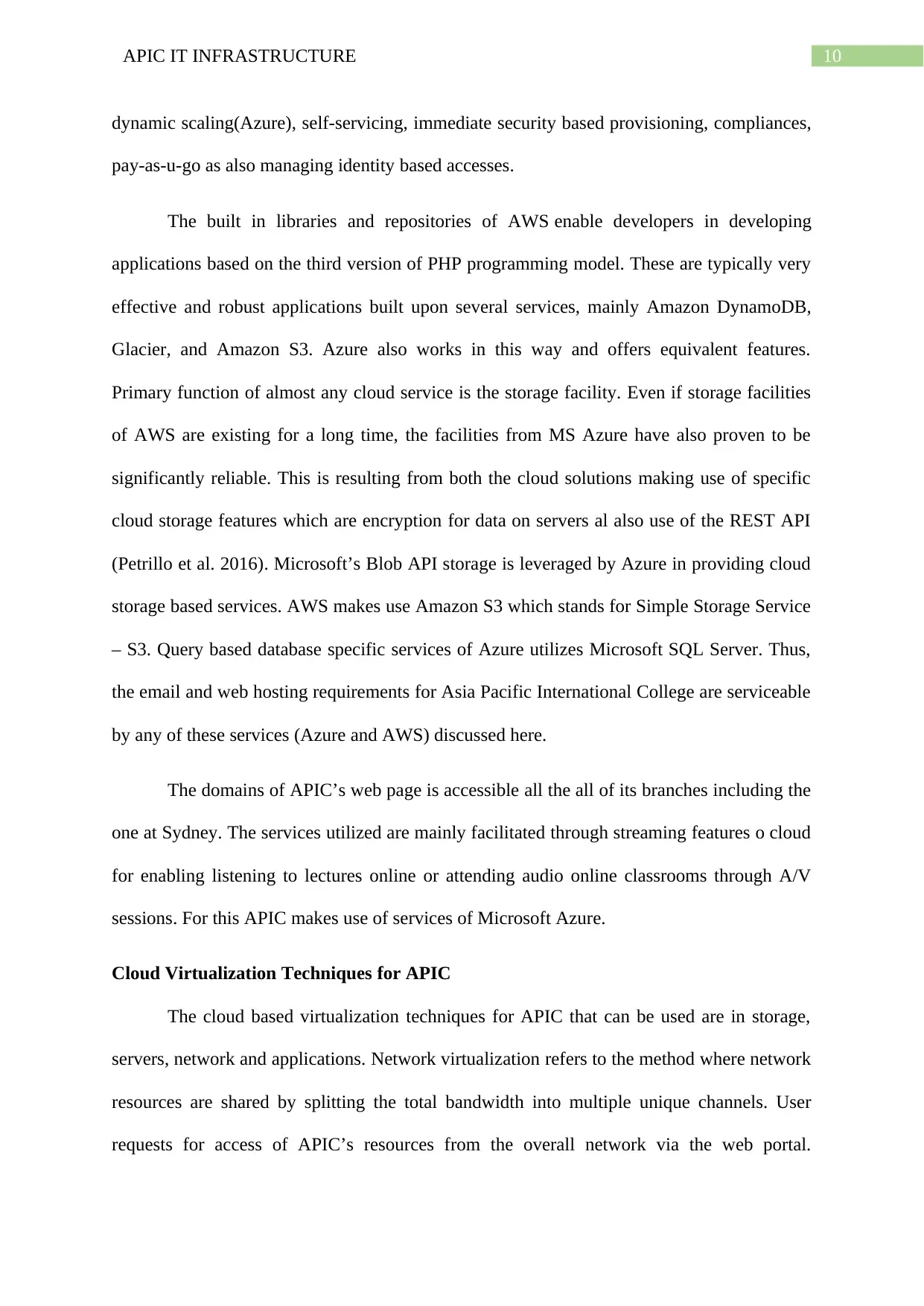
10APIC IT INFRASTRUCTURE
dynamic scaling(Azure), self-servicing, immediate security based provisioning, compliances,
pay-as-u-go as also managing identity based accesses.
The built in libraries and repositories of AWS enable developers in developing
applications based on the third version of PHP programming model. These are typically very
effective and robust applications built upon several services, mainly Amazon DynamoDB,
Glacier, and Amazon S3. Azure also works in this way and offers equivalent features.
Primary function of almost any cloud service is the storage facility. Even if storage facilities
of AWS are existing for a long time, the facilities from MS Azure have also proven to be
significantly reliable. This is resulting from both the cloud solutions making use of specific
cloud storage features which are encryption for data on servers al also use of the REST API
(Petrillo et al. 2016). Microsoft’s Blob API storage is leveraged by Azure in providing cloud
storage based services. AWS makes use Amazon S3 which stands for Simple Storage Service
– S3. Query based database specific services of Azure utilizes Microsoft SQL Server. Thus,
the email and web hosting requirements for Asia Pacific International College are serviceable
by any of these services (Azure and AWS) discussed here.
The domains of APIC’s web page is accessible all the all of its branches including the
one at Sydney. The services utilized are mainly facilitated through streaming features o cloud
for enabling listening to lectures online or attending audio online classrooms through A/V
sessions. For this APIC makes use of services of Microsoft Azure.
Cloud Virtualization Techniques for APIC
The cloud based virtualization techniques for APIC that can be used are in storage,
servers, network and applications. Network virtualization refers to the method where network
resources are shared by splitting the total bandwidth into multiple unique channels. User
requests for access of APIC’s resources from the overall network via the web portal.
dynamic scaling(Azure), self-servicing, immediate security based provisioning, compliances,
pay-as-u-go as also managing identity based accesses.
The built in libraries and repositories of AWS enable developers in developing
applications based on the third version of PHP programming model. These are typically very
effective and robust applications built upon several services, mainly Amazon DynamoDB,
Glacier, and Amazon S3. Azure also works in this way and offers equivalent features.
Primary function of almost any cloud service is the storage facility. Even if storage facilities
of AWS are existing for a long time, the facilities from MS Azure have also proven to be
significantly reliable. This is resulting from both the cloud solutions making use of specific
cloud storage features which are encryption for data on servers al also use of the REST API
(Petrillo et al. 2016). Microsoft’s Blob API storage is leveraged by Azure in providing cloud
storage based services. AWS makes use Amazon S3 which stands for Simple Storage Service
– S3. Query based database specific services of Azure utilizes Microsoft SQL Server. Thus,
the email and web hosting requirements for Asia Pacific International College are serviceable
by any of these services (Azure and AWS) discussed here.
The domains of APIC’s web page is accessible all the all of its branches including the
one at Sydney. The services utilized are mainly facilitated through streaming features o cloud
for enabling listening to lectures online or attending audio online classrooms through A/V
sessions. For this APIC makes use of services of Microsoft Azure.
Cloud Virtualization Techniques for APIC
The cloud based virtualization techniques for APIC that can be used are in storage,
servers, network and applications. Network virtualization refers to the method where network
resources are shared by splitting the total bandwidth into multiple unique channels. User
requests for access of APIC’s resources from the overall network via the web portal.
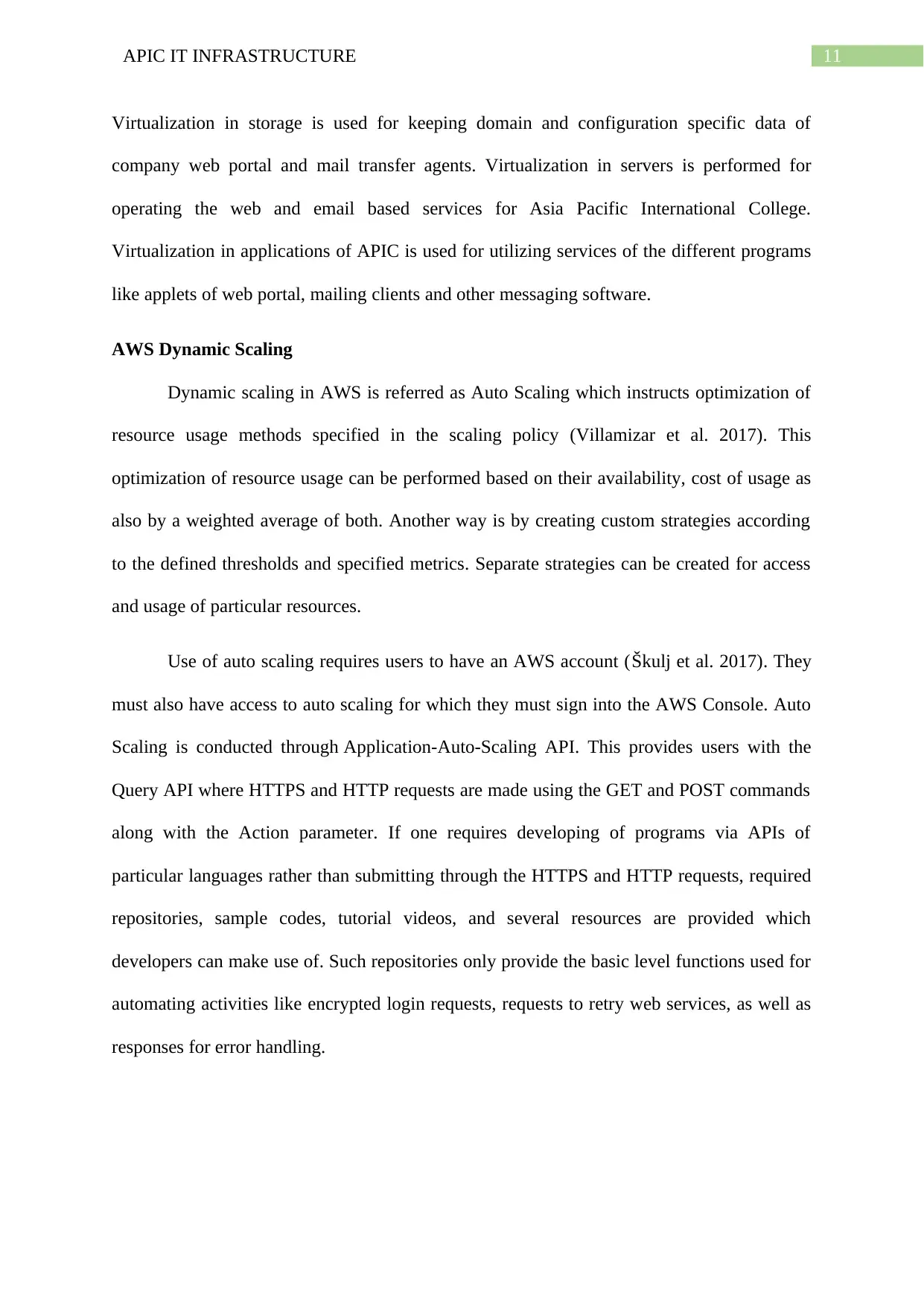
11APIC IT INFRASTRUCTURE
Virtualization in storage is used for keeping domain and configuration specific data of
company web portal and mail transfer agents. Virtualization in servers is performed for
operating the web and email based services for Asia Pacific International College.
Virtualization in applications of APIC is used for utilizing services of the different programs
like applets of web portal, mailing clients and other messaging software.
AWS Dynamic Scaling
Dynamic scaling in AWS is referred as Auto Scaling which instructs optimization of
resource usage methods specified in the scaling policy (Villamizar et al. 2017). This
optimization of resource usage can be performed based on their availability, cost of usage as
also by a weighted average of both. Another way is by creating custom strategies according
to the defined thresholds and specified metrics. Separate strategies can be created for access
and usage of particular resources.
Use of auto scaling requires users to have an AWS account (Škulj et al. 2017). They
must also have access to auto scaling for which they must sign into the AWS Console. Auto
Scaling is conducted through Application-Auto-Scaling API. This provides users with the
Query API where HTTPS and HTTP requests are made using the GET and POST commands
along with the Action parameter. If one requires developing of programs via APIs of
particular languages rather than submitting through the HTTPS and HTTP requests, required
repositories, sample codes, tutorial videos, and several resources are provided which
developers can make use of. Such repositories only provide the basic level functions used for
automating activities like encrypted login requests, requests to retry web services, as well as
responses for error handling.
Virtualization in storage is used for keeping domain and configuration specific data of
company web portal and mail transfer agents. Virtualization in servers is performed for
operating the web and email based services for Asia Pacific International College.
Virtualization in applications of APIC is used for utilizing services of the different programs
like applets of web portal, mailing clients and other messaging software.
AWS Dynamic Scaling
Dynamic scaling in AWS is referred as Auto Scaling which instructs optimization of
resource usage methods specified in the scaling policy (Villamizar et al. 2017). This
optimization of resource usage can be performed based on their availability, cost of usage as
also by a weighted average of both. Another way is by creating custom strategies according
to the defined thresholds and specified metrics. Separate strategies can be created for access
and usage of particular resources.
Use of auto scaling requires users to have an AWS account (Škulj et al. 2017). They
must also have access to auto scaling for which they must sign into the AWS Console. Auto
Scaling is conducted through Application-Auto-Scaling API. This provides users with the
Query API where HTTPS and HTTP requests are made using the GET and POST commands
along with the Action parameter. If one requires developing of programs via APIs of
particular languages rather than submitting through the HTTPS and HTTP requests, required
repositories, sample codes, tutorial videos, and several resources are provided which
developers can make use of. Such repositories only provide the basic level functions used for
automating activities like encrypted login requests, requests to retry web services, as well as
responses for error handling.
⊘ This is a preview!⊘
Do you want full access?
Subscribe today to unlock all pages.

Trusted by 1+ million students worldwide
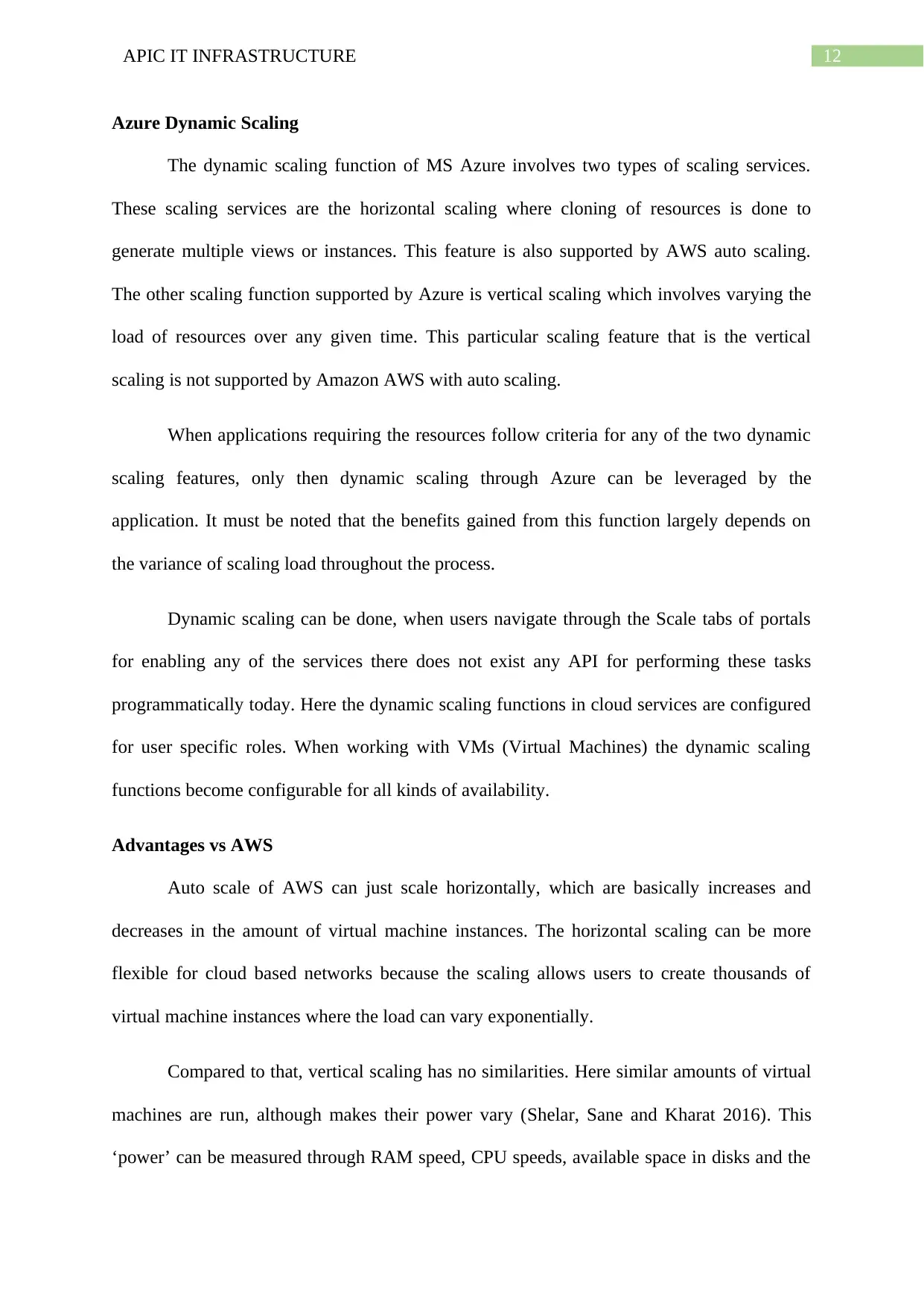
12APIC IT INFRASTRUCTURE
Azure Dynamic Scaling
The dynamic scaling function of MS Azure involves two types of scaling services.
These scaling services are the horizontal scaling where cloning of resources is done to
generate multiple views or instances. This feature is also supported by AWS auto scaling.
The other scaling function supported by Azure is vertical scaling which involves varying the
load of resources over any given time. This particular scaling feature that is the vertical
scaling is not supported by Amazon AWS with auto scaling.
When applications requiring the resources follow criteria for any of the two dynamic
scaling features, only then dynamic scaling through Azure can be leveraged by the
application. It must be noted that the benefits gained from this function largely depends on
the variance of scaling load throughout the process.
Dynamic scaling can be done, when users navigate through the Scale tabs of portals
for enabling any of the services there does not exist any API for performing these tasks
programmatically today. Here the dynamic scaling functions in cloud services are configured
for user specific roles. When working with VMs (Virtual Machines) the dynamic scaling
functions become configurable for all kinds of availability.
Advantages vs AWS
Auto scale of AWS can just scale horizontally, which are basically increases and
decreases in the amount of virtual machine instances. The horizontal scaling can be more
flexible for cloud based networks because the scaling allows users to create thousands of
virtual machine instances where the load can vary exponentially.
Compared to that, vertical scaling has no similarities. Here similar amounts of virtual
machines are run, although makes their power vary (Shelar, Sane and Kharat 2016). This
‘power’ can be measured through RAM speed, CPU speeds, available space in disks and the
Azure Dynamic Scaling
The dynamic scaling function of MS Azure involves two types of scaling services.
These scaling services are the horizontal scaling where cloning of resources is done to
generate multiple views or instances. This feature is also supported by AWS auto scaling.
The other scaling function supported by Azure is vertical scaling which involves varying the
load of resources over any given time. This particular scaling feature that is the vertical
scaling is not supported by Amazon AWS with auto scaling.
When applications requiring the resources follow criteria for any of the two dynamic
scaling features, only then dynamic scaling through Azure can be leveraged by the
application. It must be noted that the benefits gained from this function largely depends on
the variance of scaling load throughout the process.
Dynamic scaling can be done, when users navigate through the Scale tabs of portals
for enabling any of the services there does not exist any API for performing these tasks
programmatically today. Here the dynamic scaling functions in cloud services are configured
for user specific roles. When working with VMs (Virtual Machines) the dynamic scaling
functions become configurable for all kinds of availability.
Advantages vs AWS
Auto scale of AWS can just scale horizontally, which are basically increases and
decreases in the amount of virtual machine instances. The horizontal scaling can be more
flexible for cloud based networks because the scaling allows users to create thousands of
virtual machine instances where the load can vary exponentially.
Compared to that, vertical scaling has no similarities. Here similar amounts of virtual
machines are run, although makes their power vary (Shelar, Sane and Kharat 2016). This
‘power’ can be measured through RAM speed, CPU speeds, available space in disks and the
Paraphrase This Document
Need a fresh take? Get an instant paraphrase of this document with our AI Paraphraser
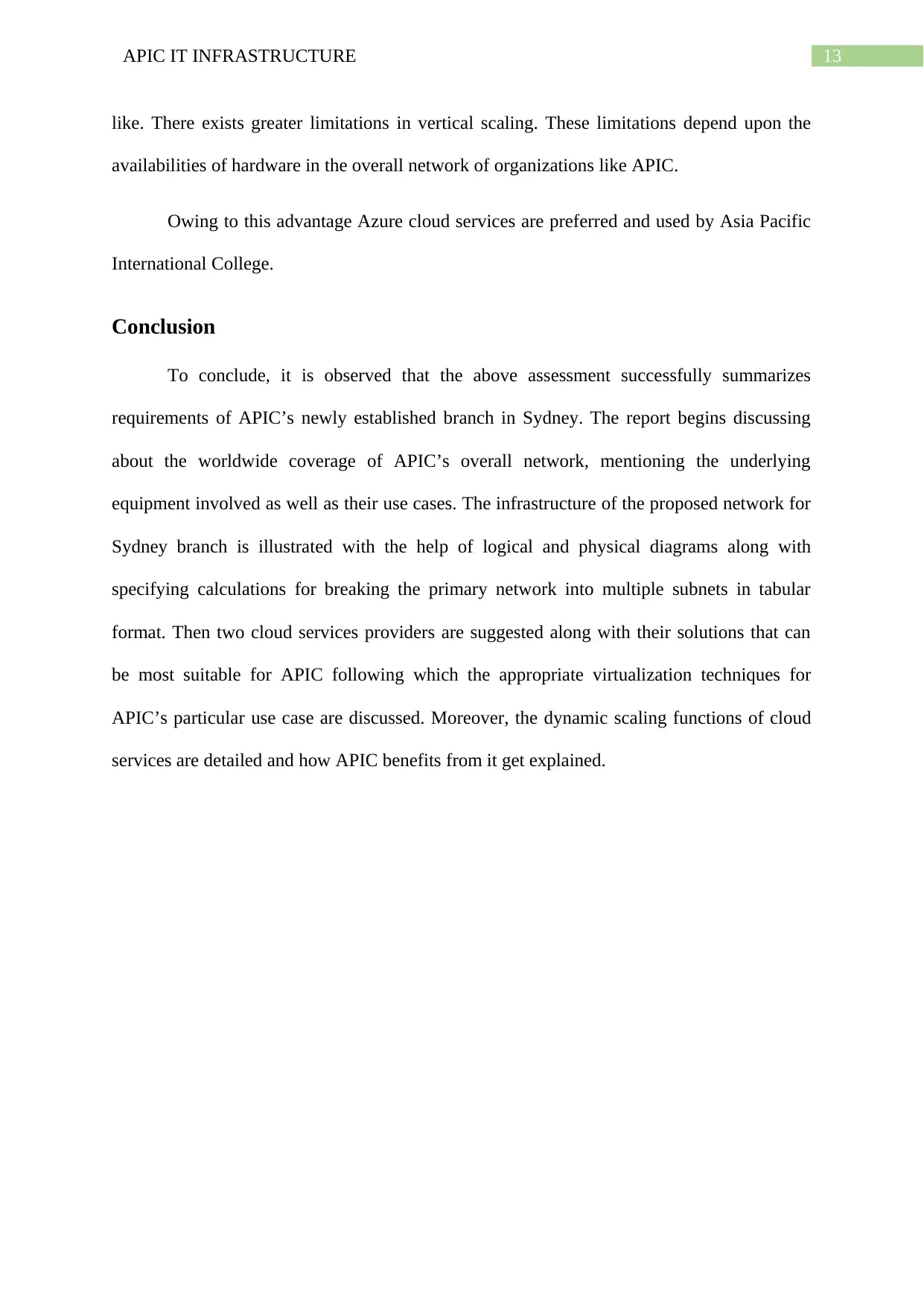
13APIC IT INFRASTRUCTURE
like. There exists greater limitations in vertical scaling. These limitations depend upon the
availabilities of hardware in the overall network of organizations like APIC.
Owing to this advantage Azure cloud services are preferred and used by Asia Pacific
International College.
Conclusion
To conclude, it is observed that the above assessment successfully summarizes
requirements of APIC’s newly established branch in Sydney. The report begins discussing
about the worldwide coverage of APIC’s overall network, mentioning the underlying
equipment involved as well as their use cases. The infrastructure of the proposed network for
Sydney branch is illustrated with the help of logical and physical diagrams along with
specifying calculations for breaking the primary network into multiple subnets in tabular
format. Then two cloud services providers are suggested along with their solutions that can
be most suitable for APIC following which the appropriate virtualization techniques for
APIC’s particular use case are discussed. Moreover, the dynamic scaling functions of cloud
services are detailed and how APIC benefits from it get explained.
like. There exists greater limitations in vertical scaling. These limitations depend upon the
availabilities of hardware in the overall network of organizations like APIC.
Owing to this advantage Azure cloud services are preferred and used by Asia Pacific
International College.
Conclusion
To conclude, it is observed that the above assessment successfully summarizes
requirements of APIC’s newly established branch in Sydney. The report begins discussing
about the worldwide coverage of APIC’s overall network, mentioning the underlying
equipment involved as well as their use cases. The infrastructure of the proposed network for
Sydney branch is illustrated with the help of logical and physical diagrams along with
specifying calculations for breaking the primary network into multiple subnets in tabular
format. Then two cloud services providers are suggested along with their solutions that can
be most suitable for APIC following which the appropriate virtualization techniques for
APIC’s particular use case are discussed. Moreover, the dynamic scaling functions of cloud
services are detailed and how APIC benefits from it get explained.
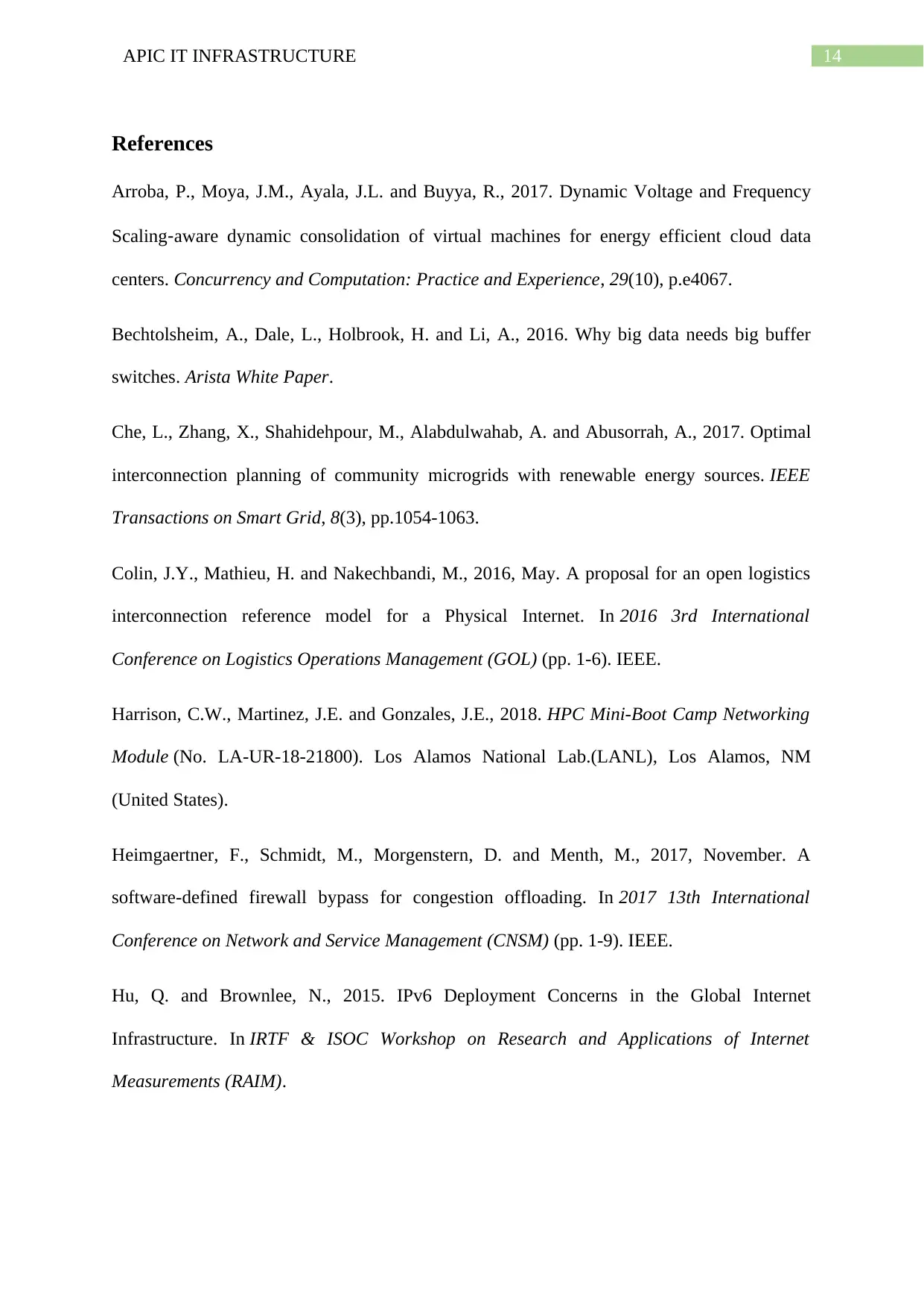
14APIC IT INFRASTRUCTURE
References
Arroba, P., Moya, J.M., Ayala, J.L. and Buyya, R., 2017. Dynamic Voltage and Frequency
Scaling‐aware dynamic consolidation of virtual machines for energy efficient cloud data
centers. Concurrency and Computation: Practice and Experience, 29(10), p.e4067.
Bechtolsheim, A., Dale, L., Holbrook, H. and Li, A., 2016. Why big data needs big buffer
switches. Arista White Paper.
Che, L., Zhang, X., Shahidehpour, M., Alabdulwahab, A. and Abusorrah, A., 2017. Optimal
interconnection planning of community microgrids with renewable energy sources. IEEE
Transactions on Smart Grid, 8(3), pp.1054-1063.
Colin, J.Y., Mathieu, H. and Nakechbandi, M., 2016, May. A proposal for an open logistics
interconnection reference model for a Physical Internet. In 2016 3rd International
Conference on Logistics Operations Management (GOL) (pp. 1-6). IEEE.
Harrison, C.W., Martinez, J.E. and Gonzales, J.E., 2018. HPC Mini-Boot Camp Networking
Module (No. LA-UR-18-21800). Los Alamos National Lab.(LANL), Los Alamos, NM
(United States).
Heimgaertner, F., Schmidt, M., Morgenstern, D. and Menth, M., 2017, November. A
software-defined firewall bypass for congestion offloading. In 2017 13th International
Conference on Network and Service Management (CNSM) (pp. 1-9). IEEE.
Hu, Q. and Brownlee, N., 2015. IPv6 Deployment Concerns in the Global Internet
Infrastructure. In IRTF & ISOC Workshop on Research and Applications of Internet
Measurements (RAIM).
References
Arroba, P., Moya, J.M., Ayala, J.L. and Buyya, R., 2017. Dynamic Voltage and Frequency
Scaling‐aware dynamic consolidation of virtual machines for energy efficient cloud data
centers. Concurrency and Computation: Practice and Experience, 29(10), p.e4067.
Bechtolsheim, A., Dale, L., Holbrook, H. and Li, A., 2016. Why big data needs big buffer
switches. Arista White Paper.
Che, L., Zhang, X., Shahidehpour, M., Alabdulwahab, A. and Abusorrah, A., 2017. Optimal
interconnection planning of community microgrids with renewable energy sources. IEEE
Transactions on Smart Grid, 8(3), pp.1054-1063.
Colin, J.Y., Mathieu, H. and Nakechbandi, M., 2016, May. A proposal for an open logistics
interconnection reference model for a Physical Internet. In 2016 3rd International
Conference on Logistics Operations Management (GOL) (pp. 1-6). IEEE.
Harrison, C.W., Martinez, J.E. and Gonzales, J.E., 2018. HPC Mini-Boot Camp Networking
Module (No. LA-UR-18-21800). Los Alamos National Lab.(LANL), Los Alamos, NM
(United States).
Heimgaertner, F., Schmidt, M., Morgenstern, D. and Menth, M., 2017, November. A
software-defined firewall bypass for congestion offloading. In 2017 13th International
Conference on Network and Service Management (CNSM) (pp. 1-9). IEEE.
Hu, Q. and Brownlee, N., 2015. IPv6 Deployment Concerns in the Global Internet
Infrastructure. In IRTF & ISOC Workshop on Research and Applications of Internet
Measurements (RAIM).
⊘ This is a preview!⊘
Do you want full access?
Subscribe today to unlock all pages.

Trusted by 1+ million students worldwide
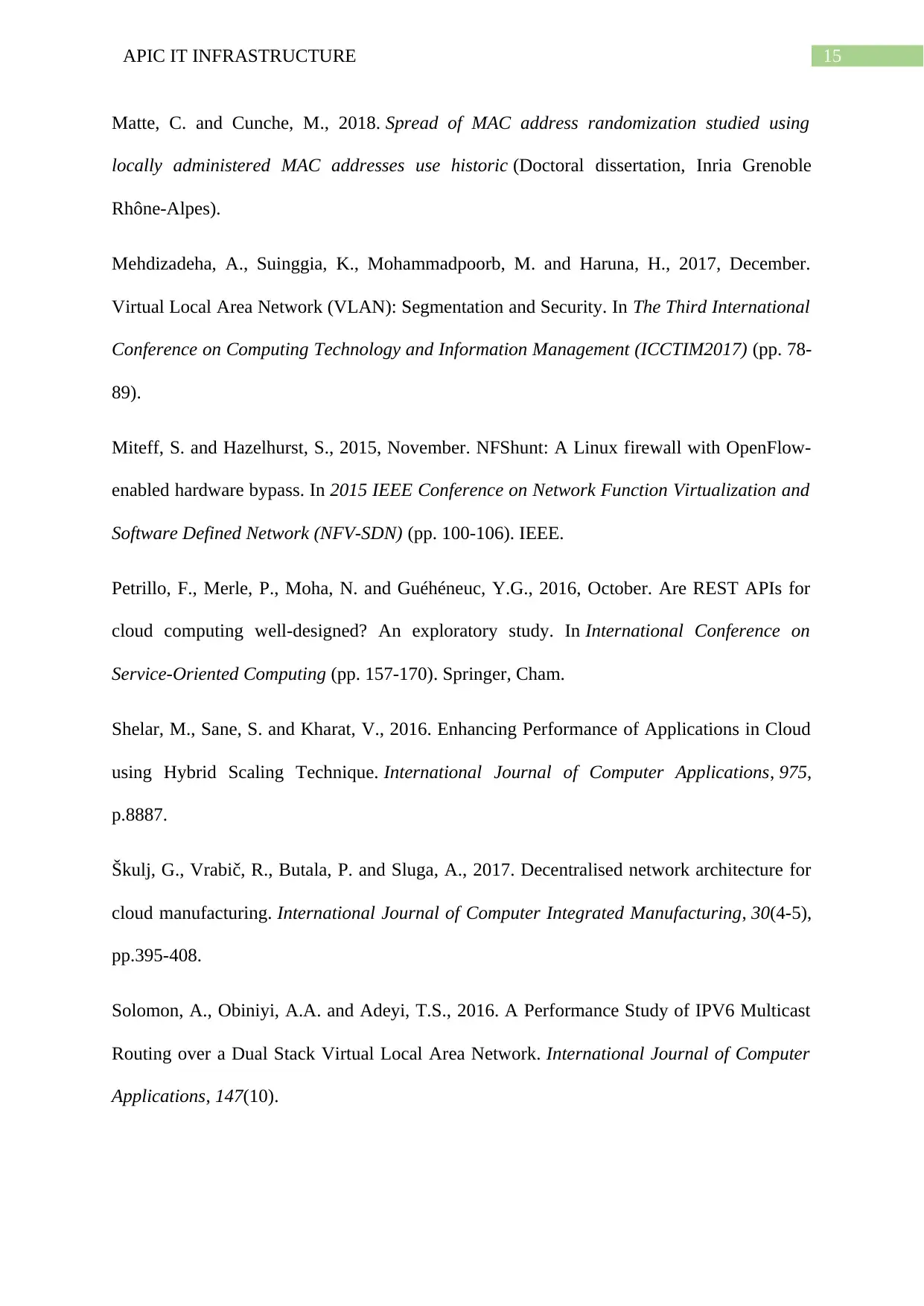
15APIC IT INFRASTRUCTURE
Matte, C. and Cunche, M., 2018. Spread of MAC address randomization studied using
locally administered MAC addresses use historic (Doctoral dissertation, Inria Grenoble
Rhône-Alpes).
Mehdizadeha, A., Suinggia, K., Mohammadpoorb, M. and Haruna, H., 2017, December.
Virtual Local Area Network (VLAN): Segmentation and Security. In The Third International
Conference on Computing Technology and Information Management (ICCTIM2017) (pp. 78-
89).
Miteff, S. and Hazelhurst, S., 2015, November. NFShunt: A Linux firewall with OpenFlow-
enabled hardware bypass. In 2015 IEEE Conference on Network Function Virtualization and
Software Defined Network (NFV-SDN) (pp. 100-106). IEEE.
Petrillo, F., Merle, P., Moha, N. and Guéhéneuc, Y.G., 2016, October. Are REST APIs for
cloud computing well-designed? An exploratory study. In International Conference on
Service-Oriented Computing (pp. 157-170). Springer, Cham.
Shelar, M., Sane, S. and Kharat, V., 2016. Enhancing Performance of Applications in Cloud
using Hybrid Scaling Technique. International Journal of Computer Applications, 975,
p.8887.
Škulj, G., Vrabič, R., Butala, P. and Sluga, A., 2017. Decentralised network architecture for
cloud manufacturing. International Journal of Computer Integrated Manufacturing, 30(4-5),
pp.395-408.
Solomon, A., Obiniyi, A.A. and Adeyi, T.S., 2016. A Performance Study of IPV6 Multicast
Routing over a Dual Stack Virtual Local Area Network. International Journal of Computer
Applications, 147(10).
Matte, C. and Cunche, M., 2018. Spread of MAC address randomization studied using
locally administered MAC addresses use historic (Doctoral dissertation, Inria Grenoble
Rhône-Alpes).
Mehdizadeha, A., Suinggia, K., Mohammadpoorb, M. and Haruna, H., 2017, December.
Virtual Local Area Network (VLAN): Segmentation and Security. In The Third International
Conference on Computing Technology and Information Management (ICCTIM2017) (pp. 78-
89).
Miteff, S. and Hazelhurst, S., 2015, November. NFShunt: A Linux firewall with OpenFlow-
enabled hardware bypass. In 2015 IEEE Conference on Network Function Virtualization and
Software Defined Network (NFV-SDN) (pp. 100-106). IEEE.
Petrillo, F., Merle, P., Moha, N. and Guéhéneuc, Y.G., 2016, October. Are REST APIs for
cloud computing well-designed? An exploratory study. In International Conference on
Service-Oriented Computing (pp. 157-170). Springer, Cham.
Shelar, M., Sane, S. and Kharat, V., 2016. Enhancing Performance of Applications in Cloud
using Hybrid Scaling Technique. International Journal of Computer Applications, 975,
p.8887.
Škulj, G., Vrabič, R., Butala, P. and Sluga, A., 2017. Decentralised network architecture for
cloud manufacturing. International Journal of Computer Integrated Manufacturing, 30(4-5),
pp.395-408.
Solomon, A., Obiniyi, A.A. and Adeyi, T.S., 2016. A Performance Study of IPV6 Multicast
Routing over a Dual Stack Virtual Local Area Network. International Journal of Computer
Applications, 147(10).
Paraphrase This Document
Need a fresh take? Get an instant paraphrase of this document with our AI Paraphraser
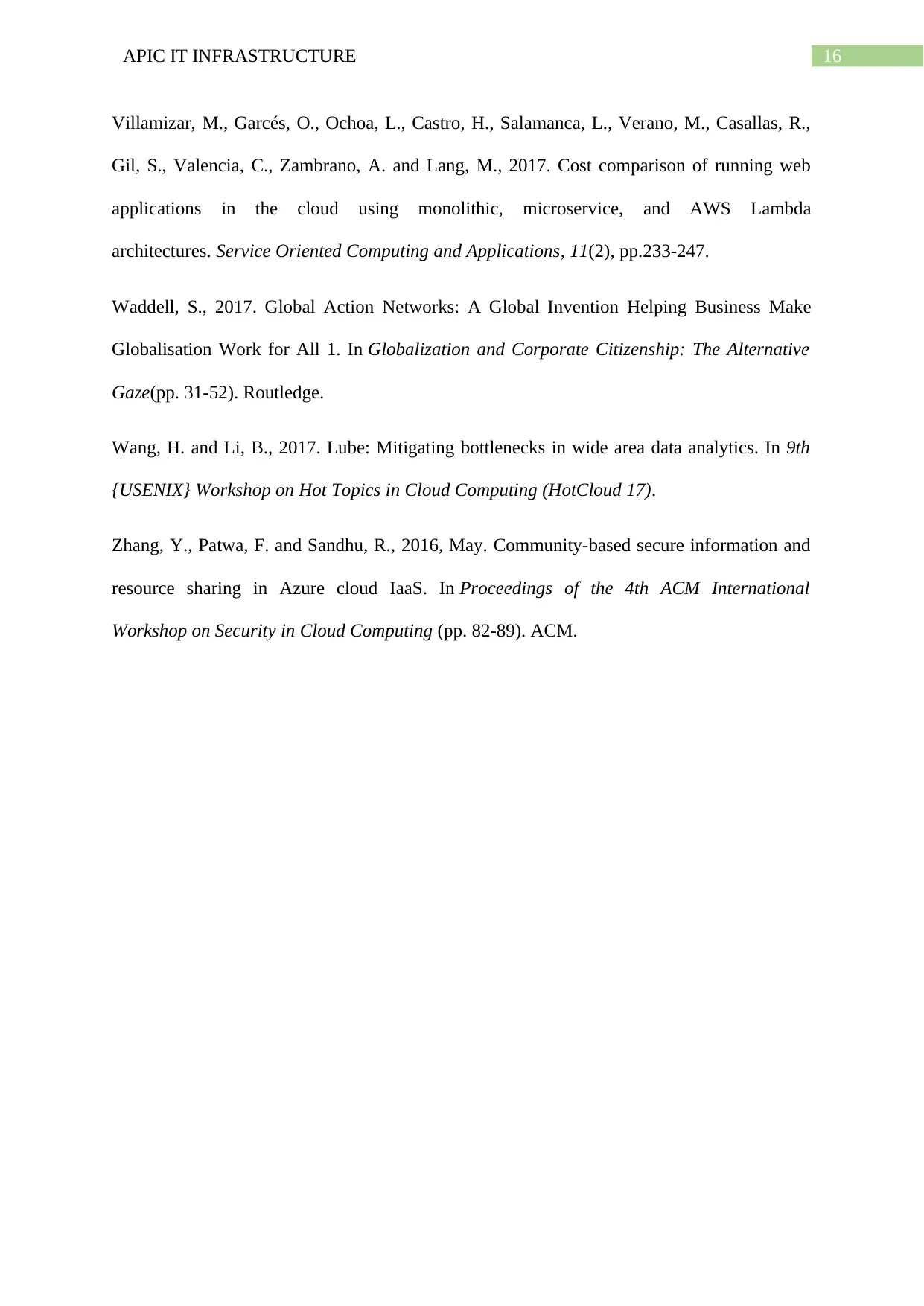
16APIC IT INFRASTRUCTURE
Villamizar, M., Garcés, O., Ochoa, L., Castro, H., Salamanca, L., Verano, M., Casallas, R.,
Gil, S., Valencia, C., Zambrano, A. and Lang, M., 2017. Cost comparison of running web
applications in the cloud using monolithic, microservice, and AWS Lambda
architectures. Service Oriented Computing and Applications, 11(2), pp.233-247.
Waddell, S., 2017. Global Action Networks: A Global Invention Helping Business Make
Globalisation Work for All 1. In Globalization and Corporate Citizenship: The Alternative
Gaze(pp. 31-52). Routledge.
Wang, H. and Li, B., 2017. Lube: Mitigating bottlenecks in wide area data analytics. In 9th
{USENIX} Workshop on Hot Topics in Cloud Computing (HotCloud 17).
Zhang, Y., Patwa, F. and Sandhu, R., 2016, May. Community-based secure information and
resource sharing in Azure cloud IaaS. In Proceedings of the 4th ACM International
Workshop on Security in Cloud Computing (pp. 82-89). ACM.
Villamizar, M., Garcés, O., Ochoa, L., Castro, H., Salamanca, L., Verano, M., Casallas, R.,
Gil, S., Valencia, C., Zambrano, A. and Lang, M., 2017. Cost comparison of running web
applications in the cloud using monolithic, microservice, and AWS Lambda
architectures. Service Oriented Computing and Applications, 11(2), pp.233-247.
Waddell, S., 2017. Global Action Networks: A Global Invention Helping Business Make
Globalisation Work for All 1. In Globalization and Corporate Citizenship: The Alternative
Gaze(pp. 31-52). Routledge.
Wang, H. and Li, B., 2017. Lube: Mitigating bottlenecks in wide area data analytics. In 9th
{USENIX} Workshop on Hot Topics in Cloud Computing (HotCloud 17).
Zhang, Y., Patwa, F. and Sandhu, R., 2016, May. Community-based secure information and
resource sharing in Azure cloud IaaS. In Proceedings of the 4th ACM International
Workshop on Security in Cloud Computing (pp. 82-89). ACM.
1 out of 17
Related Documents
Your All-in-One AI-Powered Toolkit for Academic Success.
+13062052269
info@desklib.com
Available 24*7 on WhatsApp / Email
![[object Object]](/_next/static/media/star-bottom.7253800d.svg)
Unlock your academic potential
© 2024 | Zucol Services PVT LTD | All rights reserved.





